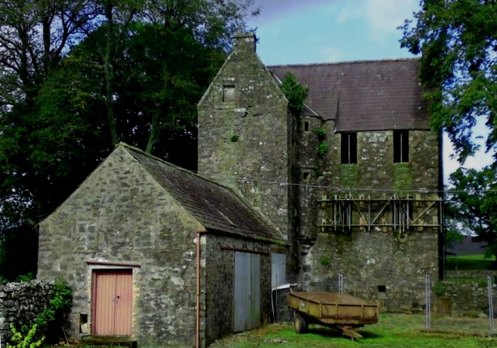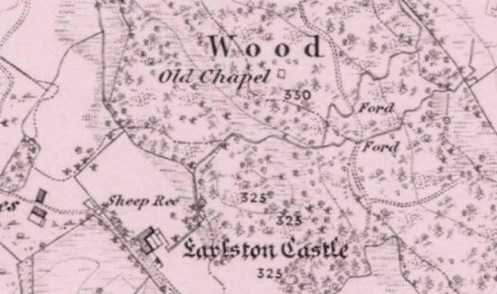The Big Oak of Earlstoun, the Old Chapel and the Five Prophets #History #Scotland

After Alexander Shields escaped from prison, he and James Renwick met and preached together at Earlstoun Wood, beside Earlstoun Castle, in December 1686. Richard Cameron and Donald Cargill also knew Earlstoun and possibly preached there in 1680. Alexander Peden may also have preached there in either 1680, or 1681. A local tradition may offer clues as to where at least some of those “prophets” of the Covenant may have preached…

In the 1850s, the ‘Big Oak of Earlstoun’ was possibly the most obvious landmark in the wood.
According to the OS Name Book:
‘About 5 chains SE. of Earlsto[u]n Castle. A large Oak tree with out spreading branches Supposed to be 300 years old. It is situate near to the S. East side of Earlsto[u]n Castle hence the name.’
Some Covenanters were later associated with trees . (See for example Cargill at the Wallace Oak, Peden’s Tree and Renwick’s Tree. However, there is no indication in local tradition that ‘The Big Oak’ was connected to the Covenanters.
The Big Oak would have begun life in 1550, if it was about 300 years old in 1850. In the 1680s, it would have been about 130 years old. Perhaps a significant tree, then, but perhaps not an obvious point in the wood for a field preaching, if the age of the tree was correctly reported. One wonders if anything of it remains?
There is a place in the woods that is connected in local tradition with the Covenanters.

The Old Chapel of Earlstoun:
‘13 Chains NE by N. of Earlsto[u]n Castle. A small quadrangular (roofless) house about 32 Links Square with only [1] apartment, the walls of which stand about 3 ft. in height. It is Situate in Earlston Wood, and is said to have erected by [Alexander?] Gordon of Earlston after the period of the Scottish persecution in 16[8]8 to commemorate the [spot] where ejected Minister of the parish and his congregation had often met for public worship, hence the name Old Chapel.’
What the tradition claims is that the Old Chapel was erected ‘after the period of the Scottish persecution’, which ended after the Revolution in the end of 1688, when Earlstoun was liberated from imprisonment in Blackness Castle. The tradition goes on to claim that it was built ‘to commemorate the [spot] where ejected Minister of the parish and his congregation had often met for public worship’.
The ejected minister of Dalry parish was John McMichan. He opposed the Restoration settlement, but was prepared to accept royal authority as he returned to the parish under the first indulgence in 1669 and remained there until 1684, when he promised to live peaceably. McMichan, a moderate presbyterian who allegedly sheltered field preachers, was not the kind of minister that Earlstoun, and especially his wife Lady Earlstoun, supported. They backed militant field preachers, and it was probably some of them, if anyone, who field preached at the site of the Old Chapel in the heart of Earlstoun’s estate.
If we assume that the tradition is correct and that the Old Chapel was built post 1688 on the spot where field preaching had taken place, then the question is, who had preached there that the Earlstoun family supported? Is this where some of the “prophets” of the Covenants had preached during the persecution of the 1680s?
Before he was imprisoned in 1683, Earlstoun knew James Renwick prior to Renwick’s ordination. He also later wrote to him from prison via his wife Lady Earlstoun. However, Earlstoun, himself, never heard him preach, even though Renwick preached somewhere in Earlstoun Wood, as Renwick was executed before Earlstoun was freed in January 1689. From what we know of Earlstoun’s politics immediately after the Revolution, he did not want to serve in the compromise of the Cameronian Regiment and he was almost certainly in the stridently militant wing of the Society people. He would later change his mind, but post 1688, he was a militant who looked back on Renwick’s ministry with fondness. The Chapel could mark the spot where Renwick and Shields preached in 1686.
It is also possible that the Old Chapel tradition refers to earlier martyrs, Richard Cameron and Donald Cargill, who both wrote to Earlstoun and to Lady Earlstoun, had stayed at Earlstoun Castle in early 1680 and may have preached there.
It is possible that Cargill may have preached there in 1681, when he made a brief field-preaching tour of the South West. Where he preached in Galloway is not known, but Earlstoun Wood may have been a logical choice for him given his connections to the family.
It is also possible that Alexander Peden preached there, as Earlstoun recalled many years later that he had called Peden to preach in Galloway, either in 1680 or 1681. It would be logical for Earlstoun to have called Peden to preach somewhere in his home parish, possibly near his house. The last time that Earlstoun saw Peden alive, he was with Cargill. Peden is said to have been at Mauchline Fair in the later half of 1680 and in Galloway in the first half of 1681.
Earlstoun Castle and Woods, including the Old Chapel, is one of the few places in Scotland, perhaps the only place, that may be associated with all five of those “prophets” of the Covenant.
Text © Copyright Dr Mark Jardine. All Rights Reserved. Please feel free link to this post on Facebook or other social networks or retweet it, but do not reblog in FULL without the express permission of the author @drmarkjardine


Excellent picture of Earlstoun Castle – home of the (fictional) Gordon’s in S.R.Crockett’s Covenanting novel Men of the Moss Hags.
callyphillips said this on December 18, 2016 at 12:52 pm |
[…] is also possible that he preached in the Wood of Earlstoun during that same tour. He had been in Galloway during that tour, as two weeks after returning to […]
‘Wilt thou become a Walloway’: Cargill and the Lord’s Cause in Carrick and Galloway | Jardine's Book of Martyrs said this on December 18, 2016 at 4:15 pm |
[…] Dr Mark Jardine has written a blog about the Big Oak of Earlson and the Covenanters here. […]
Trees with Names in Dumfries and Galloway | dgplacenames said this on May 16, 2021 at 9:37 pm |